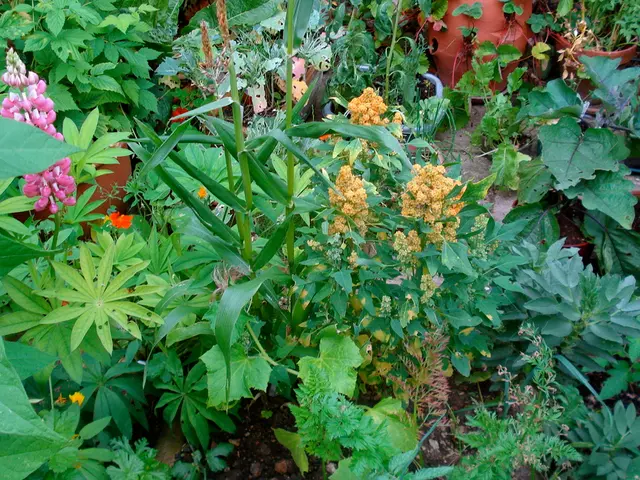8 Indoor-Grown Plants with Energy-Boosting and Digestion-Improving Properties
Indoor plants aren't just decorative; they can work to replenish your energy and bolster your body's natural balance. Here's a list of eight superfood plants perfect for your abode, designed to bring a deeper wellness vibe into your home.
Mint (The Chill Chum)
Mint grows effortlessly in little pots and offers a soothing balm for both the body and senses. Its leaves are rich in menthol, helping relax the intestinal muscles and alleviating digestive discomfort. A handful of leaves steeped in hot water creates an invigorating and focus-enhancing tea, while also easing bloating. Place your mint plant near natural light and remember to trim it regularly to encourage lush growth.
Growing tips: Mint thrives in bright light, but can tolerate some shade. It requires consistently moist soil and frequent trimming for enhanced growth. Use it in teas, salads, and infusions for digestive and calming benefits.
Ginger (The Steady Powerhouse)
Although ginger is a root meant for outdoor cultivation, it can be grown indoors too. Pick a fresh organic piece with visible eyes, and plant it in rich soil placed in a warm, well-lit spot. The emergent leaves add an ornamental touch, while the root itself can eventually be harvested. Be prepared for some patience with this one. Rich in gingerol, it boosts circulation, supports digestion, and provides a steady, grounding energy.
Growing tips: Place your ginger pot in a warm room, ideally at 70–85°F, and provide indirect light. Water it moderately, keeping soil slightly moist but not soggy. Your indoor-grown ginger plant can be used to make teas, soups, and summer rolls.
Basil (The Green Warrior)
Sweet, peppery, and lush, basil is a fantastic addition to your indoor garden. It is renowned for its medicinal qualities, including reducing inflammation, aiding digestion, and combating fatigue. Basil craves warmth and direct sunlight, making it perfect for a south-facing windowsill. Pick leaves regularly to keep the plant producing, and enjoy it fresh atop salads or grind it up with nuts, salt, and olive oil to make a delicious pesto.
Growing tips: Basil loves plenty of bright light and warm temperatures. Water when the top inch of soil is dry, and prune flower buds to promote leaf growth. Use in cooking, wellness drinks, and even aromatherapy diffusers.
Aloe Vera (The Skin Healer)
Beyond its well-known healing properties for skin, aloe vera offers impressive digestive benefits. The gel inside its thick, spiky leaves soothes the gut lining, eases constipation, and improves nutrient absorption. Aloe requires little water and flourishes in indirect sunlight, making it an easy-to-grow superfood plant. Use only the inner gel from mature leaves, avoiding the bitter yellow latex beneath the skin.
Growing tips: Place your aloe vera plant in a sunny spot with bright, indirect light. Water sparingly, allowing the soil to dry completely between waterings. Use the gel for skin care, food supplements, or to make soothing teas.
Lemongrass (The Citrus Courage)
Lemongrass can be grown from fresh stalks placed in water until roots emerge. Once planted in soil and given adequate sunlight, it develops tall, slender blades with a refreshing lemony aroma. Lemongrass contains citral, which supports digestion, offers antimicrobial benefits, and brings an uplifting energy. A stalk simmered in tea or broth delivers a gentle, invigorating lift to the body and mood.
Growing tips: Keep your lemongrass plant in a warm spot with bright light and well-drained soil. Water regularly to maintain damp soil but avoid soggy conditions. Enjoy in teas, soups, and dishes from Thai and other Asian cuisines.
Fenugreek (The Digestive Buddy)
Fenugreek is often grown as microgreens indoors, sprouting in just a few days and requiring minimal effort in a sunny spot. The delicate leaves and seeds contain fiber, iron, and compounds that regulate blood sugar and promote digestion. Add the greens to your dishes, or soak the seeds overnight and consume them for a subtle, natural digestive aid.
Growing tips: Kickstart your fenugreek growth by placing seeds on a sunny windowsill or in a seed tray for approximately 15 days, watering daily. Then, transfer the seedlings to a larger pot. Use fresh greens and seeds in meals, drinks, and as a nutritional supplement.
Dandelion Greens (The Bittersweet Liver Aid)
Although typically wild, dandelions can be cultivated in containers from organic seed. The young leaves offer a pleasant bitterness, which stimulates bile and aids digestion, while the root (grown with patience) supports liver health. Choose a wide, shallow pot and keep it in moderate light. Snip the leaves while they are still tender, and use them in salads, green juices, and detoxification-focused wellness routines.
Growing tips: Plant your dandelion seeds in well-draining soil with a sunny location, keeping soil consistently moist. Allow the leaves to mature, but harvest them regularly for a steady supply of healthy greens.
Moringa (The Nutritional Powerhouse)
Also known as the drumstick tree, moringa thrives in containers with sufficient sunlight and pruning. This plant boasts a significant nutritional profile, offering protein, iron, calcium, vitamins A and C, and antioxidants. The feathery leaves can be harvested regularly and dried or added fresh to soups, stews, and smoothies. In smaller spaces, dwarf varieties are an excellent choice for indoor growth.
Growing tips: Provide your moringa tree with plenty of bright light, ensuring at least 6 hours of direct sunlight. Water deeply but infrequently, and prune the tree occasionally. Embrace the most versatile and nutrient-dense superfood plant in your kitchen and wellness adventures.
Embrace these superfood plants at home, and watch your daily life transform into a slower, more intentional rhythm. From teas to dishes, these green wonders offer more than just nutrients; they're a peaceful, healing presence to appreciate and nurture.
Mint, a soothing and calming plant, grows effortlessly in little pots and offers a balm for the body and senses. Ginger, with its steady, grounding energy, can be grown indoors from a fresh organic piece, enriching your home with its ornamental leaves and supportive digestive benefits. Basil, renowned for its medicinal qualities, flourishes in a south-facing windowsill, adding a fresh, peppery scent to your indoor space. Aloe Vera, with its healing skin and digestive benefits, requires little water and thrives in indirect sunlight. Lemongrass, offering an uplifting energy, can be grown from fresh stalks placed in water, its refreshing lemony aroma adding a touch of citrus to your indoor environment. Fenugreek, a plant rich in fiber and irons, sprouts in just a few days in a sunny spot, making an excellent addition to your indoor garden. Each of these superfood plants, when grown at home, brings not only nutrition but also a tranquil, healing presence to your daily life.








